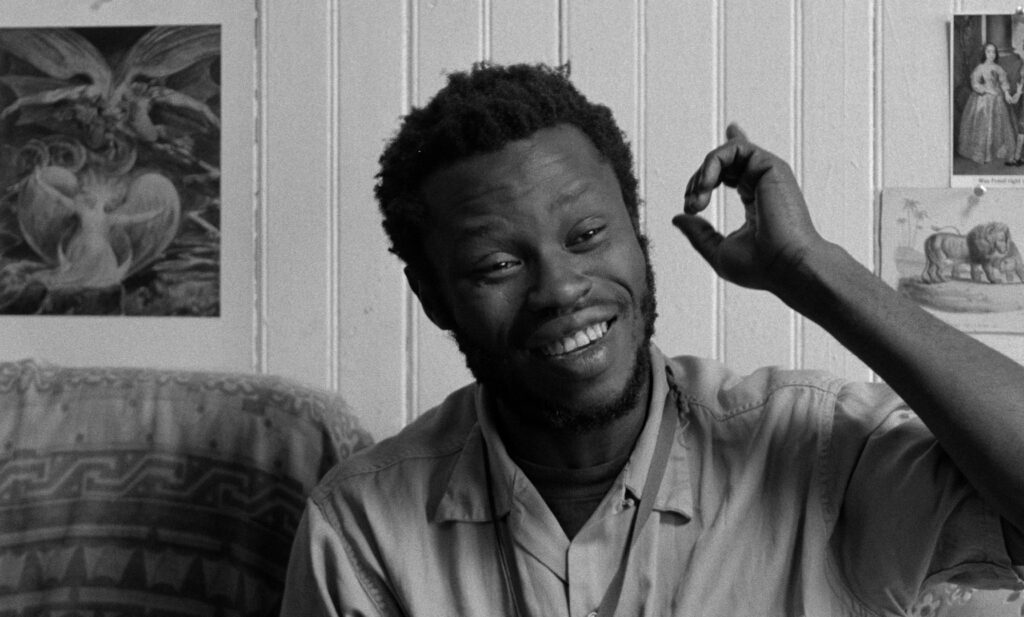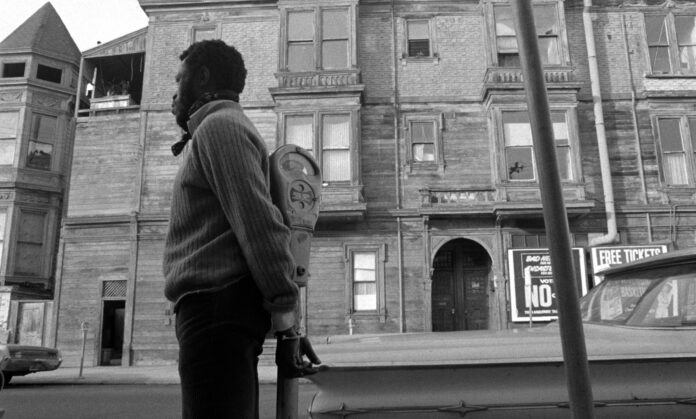The rearview mirror is the perspective of choice onscreen this week, between a diverse array of revivals, and two new documentaries about esteemed artists in various media.
The rarest of the excavations is the BAMPFA co-sponsored restoration of David Schickele’s 1971 Bushman, which won some acclaim at film festivals at the time but never got a real commercial release, then basically disappeared for decades. Its loose, semi-improvised story offers a unique perspective on a San Francisco whose mostly downscale photographed sites—few anywhere near downtown, Victorians, or the usual tourist landmarks—are barely recognizable as being part of the same city today. Gabriel (Paul Eyam Nzie Okpokam) is a Nigerian refugee from civil war who’s landed here somewhat by accident. His uncertain legal status makes it impossible to get a real job or other stable footing, even as his genial personality and fluent English gain him fairly easy entree to the Black community, hippie scene, and so forth.
Still, for all his adaptability, Gabe is an alienated stranger in a strange land. It’s a situation not helped by the cultural ignorance that leads just about everyone to treat him as an “exotic” African curiosity. That certainly applies to the relationships he falls into with women, to whom he seems a sort of novelty. (He politely declines the advances of a gay man played by none other than future Eraserhead Jack Nance.) The impressionistic, episodic narrative encompasses unexplained interludes in the countryside, its freeform progress also making room for first-person interview sequences, myriad camera and editorial gambits, and wide-ranging music on the soundtrack.
Then, after a certain point in the 74-minute feature, even that flexible framework is abandoned, and Bushman becomes a documentary about its own unmaking. The material we’ve already seen was primarily shot in 1968. But when the shoestring production was well advanced, life imitated art—I don’t want to spoil the surprise, but suffice it to say that ingratiating nonprofessional lead actor (and then-SF State instructor) Okpokam’s own immigration status became an issue, removing him from the picture both literally and metaphorically. This major hiccup endangered any hopes of completing the project, a task that wound up stretching on for years. Yet rather than nullifying Bushman, it ultimately had the effect of only heightening the complexity of the film’s questioning political and social engagement, blurring lines between drama, nonfiction, essay and protest.

The late Schickele, who passed away in SF a quarter-century ago,was a musician who joined the Peace Corps in 1961. He turned his subsequent deep ties to Nigeria, where he was posted, first into the 1966 mid-length documentary Give Me A Riddle, then Bushman. (The two films will be shown together at BAMPFA.) His directorial didn’t progress much further, but he was involved as an actor and editor on other people’s films, notably those by fellow Bay Areans Rob Nilsson, Bobby Roth and John Korty.
A fascinating artifact—not least for its extensive glimpse of the Fillmore District just before City Hall’s stepped-up “redevelopment” schemes drove many African-American residents from their own neighborhood—Bushman will be shown at BAMPFA on Sat/3 and January 24. The first date will also feature a discussion with in-person guests including Schickele family members, surviving cast, preservationists and more.
Other notable revivals in local theaters this week are nothing like Bushman—or each other, for that matter. Another film that has been scarce for some time is Nancy Savoca’s 1993 Household Saints, which was high on a list of movies (some surprisingly recent) that were overdue for reissue, as they had never been put out on post-VHS formats and/or were tied up in legal issues. Adapted from Francine Prose’s novel, it centers on a boisterous Italian-American family (played by Tracey Ullman, Vincent D’Onofrio, Judith Malina, Michael Imperioli, Illeana Douglas and others) flummoxed when young Teresa (Lili Taylor) turns out to be a living embodiment of religious purity.
Both more ambitious and more uneven than Savoca’s fine prior features True Love and Dogfight, Saints has that unmistakable feel of a literary conceit that can’t fully translate to the screen. But it’s disarmingly offbeat, and provides a memorable role for Taylor right in the middle of her run as Queen of the Indies (a throne stolen a couple years later by Parker Posey). The director herself will do a live Q&A after screening of the newly restored film at SF’s 4 Star on Wed/31.
Help us save local journalism!
Every tax-deductible donation helps us grow to cover the issues that mean the most to our community. Become a 48 Hills Hero and support the only daily progressive news source in the Bay Area.
Moving from chastity to seduction, one night prior the Balboa Theater is showing Letter From an Unknown Woman, an indifferently received 1948 Universal release that’s since been elevated to classic status. Somewhat sanitized from its source in a 1922 novella by the Austrian writer Stefan Zweig, it has Joan Fontaine as a Viennese naif around 1900, infatuated by an older concert pianist neighbor (Louis Jourdan) who barely notices her existence. Nonetheless, this unrequited love comes to define her life, for better and (mostly) worse.
The trifling romantic-melodrama story nonetheless provided an ideal vehicle for the sumptuous mobile-camera style of Max Ophuls—never mind that it’s misspelled in the opening credits as “Opuls”—who was in the middle of a brief Hollywood residency after fleeing Nazi Germany, then Nazi-occupied Paris. After a couple memorable noirs (Caught, The Reckless Moment), he’d spend the too-short remainder of his career in France. But Letter, which plays Tues/30, would gradually come to be considered one of his best.
Gleefully exchanging class for trash are two horror chestnuts playing other SF venues the same night. Roger Corman’s 1963 The Terror is infamous for being the last word in resourceful economy even for that ever-thrifty director-producer: Utilizing leftover sets from his just-finished The Raven, and star Boris Karloff for just two days’ shooting, he cobbled together a vaguely Poe-esque script to shoot in a hurry.
Once Corman had to move on, others including future directorial luminaries Francis Ford Coppola, Monte Hellman, and Jack Hill shot additional scenes—though nothing would make sense of the incoherent plot, which was further distinguished by providing a stiff leading-man role for another then-unknown, Jack Nicholson. This castle-set Gothic whatsit, which throws in ghosts, Satan and a witch, remains a “Frankenfilm” par excellence, sewn from other movies’ stray parts into a chaotic, inorganic yet oddly engaging whole. For extra funk value, the Roxie will be showing Terror on 16mm on Tue/30.
Equally cheesy though umpteen times more expensive was John Carpenter’s “space western” Ghosts of Mars, a 2001 flop that spelled the end of his major-studio career to date. it was rumored that this was originally conceived as another Escape From New York sequel, which the writer-director denied. But it would make a certain amount of sense as such—and god knows neither top-billed Natasha Henstridge or Ice Cube do much to fill Kurt Russell’s boots. (Nor does Jason Statham, smirking through his first Hollywood role.)
Pam Grier, Clea DuVall, and Joanna Cassidy are also involved in a cartoonish sci-fi horror action plot involving Earthlings colonizing 22nd-century Mars being violently “possessed” by its existing inhabitants. Suddenly they start looking like Scandinavian death metal band members, decapitating people with flying discs and otherwise being mean. In solidarity, Carpenter’s own musical score eschews his usual synth sounds for rock guitar.
It’s hard to make a case for this pretty brainless perpetual-motion machine getting the critical reevaluation merited by some of the director’s other commercial failures (including The Thing, Big Trouble in Little China, or In the Mouth of Madness), though of course it has its defenders. There is some fun to be had—god knows more than in either of the prior year’s big-budget busts Mission to Mars and Red Planet. It plays the Alamo Drafthouse New Mission Tue/30.
Fans of horror cinema won’t want to miss Dario Argento: Panico, a new documentary portrait of the Italian auteur who’s been mining that genre for over half a century now. As the title suggests, his own creative process is filled with anxiety—he certainly acts (as well as looks) the part of a haunted, neurotic Edgar Allan Poe character, offscreen as well as on. Simone Scafidi’s well-made career overview draws on commentary not just from the man himself, but family members (including daughter Asia), collaborators (Luigi Cozzi, Lamberto Bava, Michele Soavi, composer Claudio Simonetti of Goblin), and some of those he’s influenced—Gaspar Noe, a slavishly admiring Nicolas Winding Refn, and particularly incisive Guillermo del Toro (who says (“everything in Argento’s movies is trying to kill you…the universe is malignant”).
There’s a lot of intriguing behind-the-scenes footage from his movies, revealing the painstaking craftsmanship behind the often dazzling if blood-soaked visual design of strikingly stylish films like the original Suspiria and his early giallo thrillers. Panico’s chronological progress does skim past some significant career chapters, including his pre-directorial years as a screenwriter, and it doesn’t even touch on his 21st-century work, which admittedly has seen a decline in quality. But the only really disappointing factor here is that there are relatively few film excerpts, presumably for rights/budgetary reasons; too often we have to make do with trailers, still photographs, and other materials that can’t convey the operatic sweep of his grisly set-pieces. Still, this is a valuable companion piece to a singular career. Panico begins streaming on genre flatform Shudder this Fri/2.
The horror is offscreen yet inescapable in Vishniac, Laura Bialis’ documentary about another Jewish German refugee (like Max Ophuls), one who became primarily famous as a photographer—and for capturing images of communities soon to be wiped out by the Nazis. Roman Vishniac’s own parents had been well-off Moscovites forced to flee post-revolution Russia two decades before he himself would be chased out of Europe. Among his many hats were that of microbiologist, a field he helped popularize much later with a series of classroom educational films—even though many scientists found him sometimes laughably ill-informed in his alleged expertise.
But his chief legacy would prove the pictures he took of Eastern European Jewish ghetto life in the mid-to-late 1930s, as commissioned by a US organization hoping to raise relief funds. Adventurous, forward-looking examples of photojournalism, they gained an almost immediate incalculable historic value for preserving a glimpse of cultures, neighborhoods, businesses and individuals that would largely be exterminated in the concentration camps. Vishniac barely escaped that fate himself, fleeing with his first wife and children to America at the perilously late date of 1940.
A surviving offspring and various grandchildren are the primary character witnesses here. Often celebrated as a “Renaissance man,” Vishniac lived a long life (he died in 1990 at age 92) that these family members view in somewhat more complicated terms—he was a self-promoting fabulist, his ample genuine achievements and experiences increasingly filigreed to delusional degrees. Eager to be all things to nearly all people, he was evidently not much of a father or husband, however.
Nonetheless, the various collections he left behind, including an archive at UC Berkeley, will maintain his stature as a figure of considerable importance. Vishniac plays BAMPFA with Bialis in attendance on Sun/4, then again Fri/24 (more info here). There will also be an open house earlier on the 4th at The Magnes Collection in Berkeley, which is currently displaying two Vishniac-related exhibitions (more info here).





